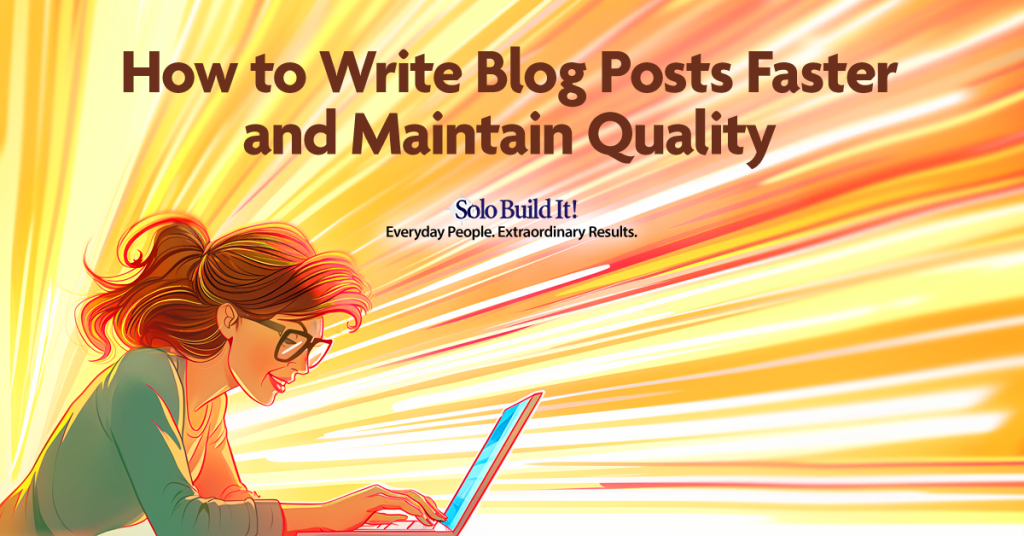Do you ever feel like there just aren’t enough hours in the day to write all your blog posts? This article explores strategies to speed up your writing process.
It’s not just about churning out content. The real challenge lies in matching speed with quality.
This delicate balance is crucial for bloggers who aim to produce engaging, high-quality blog articles consistently without compromising the integrity of their content.
In this guide, we dive into seven effective strategies that streamline your blog writing process, ensuring that each post, no matter how quickly produced, still hits the mark with your audience.
Get ready to transform your blogging routine, boosting both efficiency and quality!
1. Lay the Foundation
A well-thought-out writing process is the backbone of efficient blog content creation. It’s about establishing a structured approach that guides you from conception to completion of each blog post.
This process begins with selecting blog post topics that not only resonate with your audience but also align with your blog niche.
A solid process ensures that each step, from researching to writing, is done methodically and efficiently, cutting down on time spent meandering through ideas or grappling with writer’s block.
Central to this organized approach is the use of a content calendar. This invaluable tool serves as a roadmap for your blogging journey, allowing you to plan and organize blog topics ahead of time.
It’s not just a schedule. It’s a strategic plan that helps you manage your content creation process.
This foresight enables you to align your posts with upcoming trends, seasonal events, or key dates relevant to your audience.
Moreover, a content calendar aids in maintaining a consistent publishing rhythm, a crucial factor in building and retaining blog traffic.
It also provides a bird’s-eye view of your content strategy, helping you spot gaps or opportunities for diversification in your subject matter.
2. Use Efficient Writing Techniques
To write blog posts faster, honing your writing skills and typing speed is essential.
Improved typing speed directly translates to quicker content creation, allowing your thoughts to flow onto the screen without delay. Consider practicing with typing tools or games to increase your speed and accuracy.
Simultaneously, refining your writing skills can drastically reduce the time spent on editing and restructuring your posts. Engaging in regular writing exercises, reading widely and using AI writing tools can sharpen these skills.
Implementing a blog post template is another powerful strategy for efficiency. Templates act as a repeatable framework, guiding the structure of your blog posts and saving valuable time.
They ensure that each blog post maintains a consistent format, which not only speeds up the writing process but also helps in maintaining the quality of the content.
This structured approach allows you to focus more on the creative aspect of writing, like infusing your unique voice and insights into the post, rather than getting bogged down by layout decisions for each new article.
By integrating these techniques into your writing process, you’ll find yourself crafting amazing blog articles more swiftly and confidently.
3. Streamline Your Idea Generation Process

Efficiently generating blog post ideas is a crucial step in speeding up your writing process. One effective technique is to maintain an ongoing list of ideas.
This list becomes a reservoir of inspiration, ensuring you’re never at a loss for what to write next.
Regularly update this list with fresh topics, interesting queries from your audience, or emerging trends in your niche. This practice not only saves time. It also keeps your content relevant and engaging.
Another time-saving tip is to use AI writing tools like Tai to provide new topic ideas and expedite the process of structuring your blog posts.
These tools help in quickly transforming a raw idea into a detailed outline, including key points and subtopics that you need to cover.
This preliminary organization streamlines the actual writing, allowing you to focus on fleshing out the details rather than figuring out the flow of content.
4. Craft the Perfect Blog Post Outline
Creating a solid outline is a pivotal step in writing blog posts faster. Here’s a step-by-step guide to crafting an effective outline:
- Start With a Strong Title: Your blog post title should be captivating and clear. Use a relevant keyword to enhance SEO and give readers a precise idea of what to expect.
- Define Your Main Point: Identify the key message or idea you want to convey. This forms the backbone of your post, ensuring you stay focused and relevant.
- Organize Your Subtopics: Break down the main point into subtopics. This gives structure to your writing and makes it easier for readers to follow your argument or narrative.
- Include Examples and Data: Plan where to include supporting examples, data, or personal anecdotes. This enriches your content and provides more value to your readers.
- Decide on a Conclusion: Outline your conclusion to ensure it effectively summarizes the post and reinforces your main points.
A well-structured outline simplifies the writing process, enabling you to transition smoothly from one section to the next.
It also reduces the time spent on organizing thoughts while you’re writing and ensures a coherent flow of ideas. This results in a quality blog post that resonates with your audience.
5. Optimize the Writing Environment
An environment conducive to writing is key to turning productive time into high-quality blog posts swiftly. Create a work space where your creative juices can flow uninterrupted.
First, identify a physical space that minimizes distractions. Whether it’s a quiet corner in your home or a local café that sparks your creativity, the right environment can enhance your writing flow.
Managing digital distractions is also crucial. If digital interruptions are a challenge, consider using apps that block social media during your writing hours.
If your creative peak is during unconventional hours (you’re a night owl), embrace it! The stillness of the night can be conducive to focused writing.
Remember, your environment isn’t just physical. It’s also about the mental space you create for writing.
A brief, focused writing session can be more productive than a couple of hours filled with interruptions.
Setting specific times for writing, tailored to when you feel most energized and inspired, will help you craft amazing blog articles more efficiently.
In the end, it’s about knowing what works for you and harnessing that environment to its fullest potential.
6. Establish Writing and Editing Strategies
Maximizing your writing flow and minimizing editing time is crucial for fast blog post-production. Here are some strategies:
- Pre-Writing Rituals: Establish rituals that signal your brain it’s time to write. It could be a cup of coffee, a short walk, or a particular playlist. This helps you enter a focused writing mode quicker.
- Voice Typing Tools: If you’re more of a talker than a typer, voice typing tools can be a game-changer. They allow you to dictate your thoughts quickly. Once set up, they can significantly boost your writing speed.
- First Draft Freedom: Write your first draft without self-editing. Getting your ideas down without interruption enhances flow and can be a big time-saver.
- Effective Editing Tools: Use editing tools for the first round of revisions. Tai Freestyle, one of Tai’s modules, will catch basic spelling and grammar errors, saving you time in the editing stage.
- Timed Writing Sessions: Use a timer to write in focused bursts (like 15-30 minutes), followed by a short break. This keeps your mind fresh and maintains a steady pace.
- Editing in Layers: Tackle different aspects of editing in separate rounds—first for structure, then language, and finally for typos. This organized approach makes editing more efficient.
By applying these strategies, you’ll find that both your writing and editing processes become more streamlined, leading to faster creation of high-quality blog posts.
7. Hit Publish Faster: Your Blog Post Quality Checklist
Before you publish your new blog post, you want to ensure that it satisfies your (and Google’s) quality standards.
What’s the fastest way to do this? Use a checklist that ticks off all the relevant questions and helps you assess your post’s quality.
Conveniently, we’ve got just the checklist you need! Download your free copy now and streamline your quality control process.
Wrapping Up
In the world of blogging, speed doesn’t have to come at the cost of quality. Writing blog posts faster while maintaining excellence is an art you can master.
So, how to write blog posts faster while ensuring your content remains top-notch?
Here’s a quick recap:
- Efficiently plan with a content calendar
- Use writing techniques and templates
- Streamline your idea generation process
- Craft solid outlines using AI
- Optimize your writing environment
- Employ writing and editing strategies
- Use a checklist to streamline your quality control process
Want more tips for growing your blog and online business?

Latest posts by Margit Streifeneder (see all)
- From Traffic Peaks to Auto-Pilot: A Psychologist’s Website Success Story - March 27, 2025
- From Swim Teacher to Solopreneur: Building Passive Income Online - February 27, 2025
- From Concierge to Global Tours: 10 Lessons for Travel Business Growth - December 19, 2024






